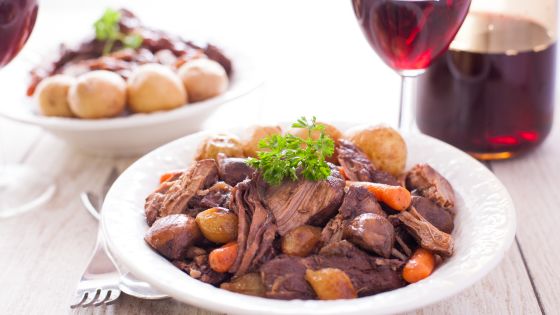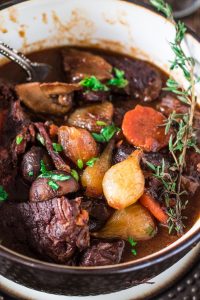J’aime la France

Bœuf Bourguignon ( beef stewed in red wine)
This dish originated from the Burgundy (Bourgogne) region in France. Burgundy is located 100 km southeast of Paris, and it stretches 360 km wide. The dish consists of beef stew braised in red wine and beef broth. It is normally flavored with carrots, onions, garlic, bouquet gars, and garnished with pearl onions, mushrooms, and bacon. Traditional preparation normally take two days, for the meat to properly tenderize and intensify the flavors. This Burgundy region of Eastern France, where the area is renowned for extraordinary wine, prized Charolais cattle, and architecture. It is normally served with garlic croutons but can be also served with steamed potatoes, macaroni noodles with a garnish of Burgundy, which is normally made with mushrooms, bacon, and sauteed onions glazed brown.

As far as cultural perspectives are concerned, this dish is popular during holidays and big family dinners. In France, the boeuf bourguignon is a delicacy served in the family for holiday meals or regular meals at restaurants, large and small, such as canteens. A canteen is a place in a factory, shop, or office where workers can have meals. Being that the main ingredients are beef and wine, this dish is quite overlooked when being looked at by vegetarians and vegans. With the amount of red meat in this dish, I question if it could be prepared with a different meat option.
Biological and environmental perspectives:
Referring back to our session with Dr. Bonnie Perdue when we discussed Psychology and Neuroscience and how the brain sends messages to our bodies compelling us to eat certain things and stray away from eating others. So we wonder why does this really happen? Why are humans naturally drawn to fats, sugars, and salts? So that question, we will never really know the answer to. From the New York Times Magazine reading “The Quest to Make a True Blue M&M,” the purpose of this article was to understand how the human eye becomes attracted to blue M&M rather than a red or brown M&M. The color blue is extremely rare, and normally is not a candy color that is usually chosen often. We should ask ourself, is blue, really blue? Or the food that we put into our body, is it really what they say it is? When discussing with one of my professors, I asked him if he liked the dish when it was cooked in his home by his mother, or cooked by a restaurant. He expressed that his family had a garden, and they would grow fresh vegetables, in fact the vegetables that are used in this dish. I asked if “When you tried this dish in a public setting, was it better or worse than his mother’s cooking?” He replied by saying, “No, my mother’s cooking will always be better.” This example proves that foods are clearly mistaken for what they truly are.
When I travel to France, I plan to try this dish at the famous Au Bourguignon du Marais.